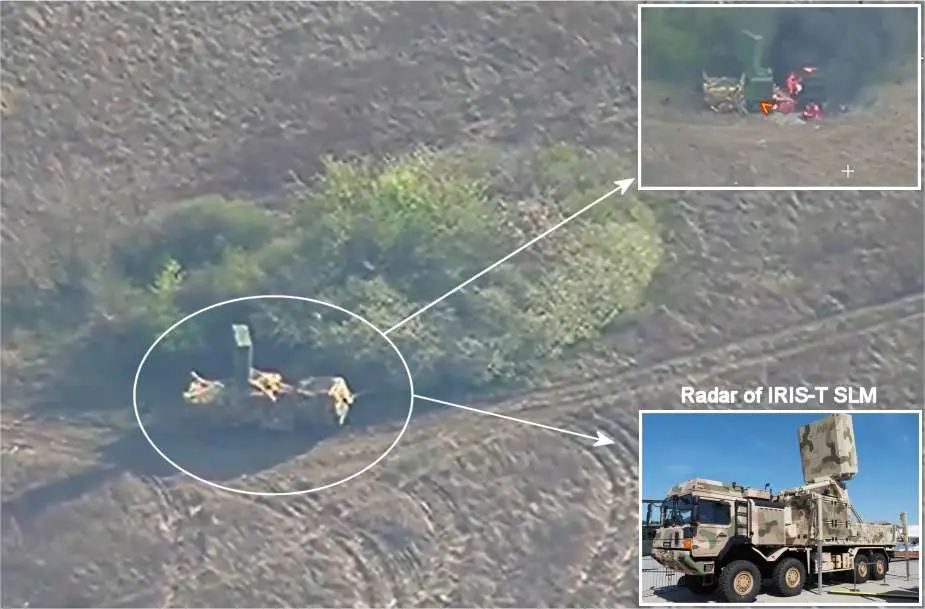- Army
- Conflicts in the world
- Israel - Iran conflict 2025
- Pakistan - India Conflict 2025
- Russia Ukraine War 2022
- Libya conflict day by day
- HAMAS - Israel War 2023
- Operation Serval in Mali French Army
- Sangaris operation Central African Republic
- Sangaris opération militaire République Centreafrique
- Ukraine - Russia conflict
- Syria conflict news
- Defence & Security Industry Technology
- Armies in the world
- Analysis Defense and Security Industry
- Conflicts in the world
- Navy
- Air
Russia Reveals Images of Possible Destruction of a Ukrainian IRIS-T SLM Air Defense System
Images released by the Russian Ministry of Defense on April 14, 2024, have showcased an attack on Ukraine's air defense capabilities. A Russian explosive device targeted the TRML-4D radar and launcher unit of the Ukrainian IRIS-T SLM air defense system near Horokhovatka, in the Izium region. However, some observers immediately suspected the use of mock-ups in the attack.
Follow Army Recognition on Google News at this link

Images published by the Russian Ministry of Defence show an attack on a Ukrainian TRML-4D. (Picture source: Russian MoD)
The IRIS-T SLM system, which includes three launcher vehicles and a mobile command center, plays a crucial role in Ukraine's defense against aerial threats, capable of intercepting and neutralizing various missile types within a 40-kilometer range. This system, noted for its advanced tracking and surveillance capabilities, saw its radar component compromised in the recent attack, raising concerns about a temporary reduction in air defense capabilities.
The IRIS-T SLM is a medium-range air defense system designed by Germany and currently used by Ukraine. It is equipped with missiles each weighing 87.4 kg and measuring 2.94 meters in length. These missiles can reach targets at Mach 3 speed and have a maximum range of 40 kilometers. They are armed with high-explosive fragmentation warheads, effectively destroying targets by dispersing shrapnel upon impact.
The guidance system of the IRIS-T SLM is based on infrared homing, which allows the missiles to track their targets through emitted heat. To enhance the system's accuracy and responsiveness, the IRIS-T SLM integrates various radar and combat control equipment, including the Saab Giraffe radar, CEA Technologies CEAFAR multifunction radar, Terma A/S Skymaster combat control system, TRML-4D multifunction radar, and Airbus Tactical Operation Centre. These combined technologies provide advanced capabilities for detecting, tracking, and engaging aerial targets, thus increasing the system's combat effectiveness.
Given the importance of the TRML-4D and the limited number of these units delivered to Ukraine (only one delivery has been confirmed), the damage could represent a significant material loss for Ukrainian military capabilities. However, the extent of the damage and the operational status of the radar post-attack remain uncertain due to the poor quality of the available images.
Some observers have expressed skepticism about the authenticity of the images released by the Russian government, suggesting that the equipment destroyed might have been merely a mock-up. Typically, hits on decoys are characterized by extensive wooden debris at the point of impact, which was not observed here. Additionally, only the tires were seen burning, whereas a mock-up made of wood and other flammable materials would burn more extensively. There are arguments on both sides, and further clarification from the Ukrainian military on this matter might be necessary.
This event underscores the intense focus on degrading high-value assets such as advanced radars and air defense systems, which are pivotal in the ongoing conflict between Ukraine and Russia. Air superiority is a critical issue at this time, with the Russians looking to intensify their strikes and the Ukrainians aiming to clear the way for future F-16 deployments.



























